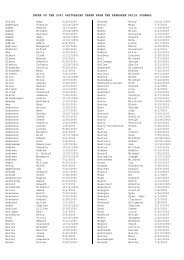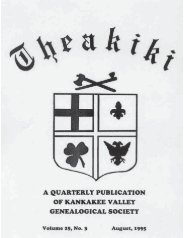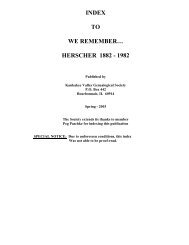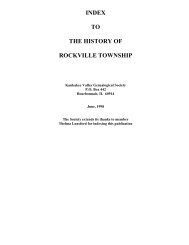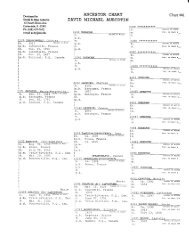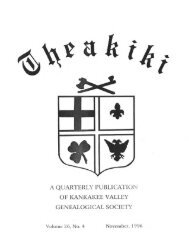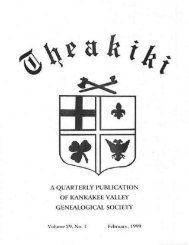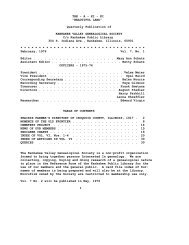2 - Kankakee Valley Genealogical Society
2 - Kankakee Valley Genealogical Society
2 - Kankakee Valley Genealogical Society
Create successful ePaper yourself
Turn your PDF publications into a flip-book with our unique Google optimized e-Paper software.
stories he had told to his Canadian countrymen, of how fortune smiled on the<br />
frugal and industrious in his adopted home, Illustrated and corroborated by<br />
his own success in the accumulation of landed wealth, kindled their<br />
imaginations. His reports were published far and wide. One who was induced<br />
by them to try his fortune on the <strong>Kankakee</strong>, makes the following statement:<br />
"They read like interesting romance. They caused a great sensation. In<br />
some localities people became greatly excited and prepared to sell their<br />
farms and holdings forthwith in order to go at once to the new country."<br />
But it Is said that the immigration to Bourbonnais did not commence until<br />
1844. That year there came the Rivards, St. Plerres, Flageoles, Legris,<br />
Delunais, Lapolice, Martins, Savoies, Belgards, Lafluers, Coriveaux and<br />
other families no less prominent.<br />
LeVasseur interested himself actively in the welfare of all the new<br />
accessions to the colony. He located their land at the government land<br />
office; sold them land, and helped them to build their homes. In 1846 the<br />
early reports of LeVasseur, concerning this splendid county, were revived;<br />
and that year witnessed perhaps the largest number of French Canadian<br />
Immigrants to Bourbonnais. In 1847 three men came on behalf of Canadian<br />
friends and relatives to investigate conditions and report thereon. They<br />
were John B. Letourneau, Captain Fortin and Alexander Boucher. They all<br />
returned to Canada, carrying back most encouraging reports of the general<br />
prosperity enjoyed by the Bourbonnais settlers. But with them had came<br />
George R. Letourneau and Godfrey Mathieu, who remained and became permanent<br />
and substantial factors in building up this prosperous community. The next<br />
year, others came, moved by the favorable reports of John B. Letourneau and<br />
his associates of the preceding year.<br />
Among those who came in the years 1846, 1847 and 1849 were Peter Spink, the<br />
four Fortin brothers and families, the two Langlois brothers and their<br />
families, the Dellibacks, David Granger, the Brosseaus, Joseph E. Labrie,<br />
the Bissettes, Rossettes, Lesages, and Alexis Carrom. The French<br />
immigration practically ceased with the years 1850, 1851 and 1852. Among<br />
the last immigrants were the families of the Grandpre brothers, of<br />
Constantin, of the two Berard borothers, the Lesages and Brais.<br />
For years all immigrants from Canada, whatever their ultimate objective,<br />
came primarily to Bourbonnais and made this the base of their first plans<br />
and operations in the new country. Many of them settled afterwards in other<br />
portions of the county or in neighboring counties. Our appreciation of the<br />
Importance of the French settlement here and our interst in it must be<br />
greatly increased when we pause to think that from it went forth the people<br />
who established every other French town in <strong>Kankakee</strong> and Iroquois Counties.<br />
<strong>Kankakee</strong> is a large measure, St. Anne, LeErable, St. Mary, Papineau, all<br />
must acknowledge Bourbonnais as the mother; and, more than that, from old<br />
Bourbonnais and these, her nearby children, sprang all that French Canadian<br />
colonies of Kansas, Iowa, Minnesota and the Dakotas.<br />
This is the story of Bourbonnais and the early French settlement thereof;<br />
but we must not leave the account of LeVasseur so incomplete. He was united<br />
in marriage with Miss Ruth Bull, of Danville. As the issue of this marriage<br />
there were eight children, four boys and four girls; all of whom are now<br />
deceased, except one, Mrs. Dr. Monast, of Chicago. Mrs. LeVasseur was a<br />
- 4 -




